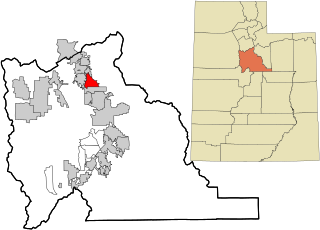
Dallin Harris Oaks is an American jurist, educator, and religious leader who since 2018 has been the First Counselor in the First Presidency of The Church of Jesus Christ of Latter-day Saints. He was called as a member of the church's Quorum of the Twelve Apostles in 1984. Currently, he is the second most senior apostle by years of service and is the President of the Quorum of the Twelve Apostles. However, consistent with long-established practice, due to Oaks serving in the First Presidency, M. Russell Ballard currently serves as the quorum's acting president.

The BYU College of Family, Home and Social Sciences is a college located on the Provo, Utah campus of Brigham Young University and is housed in the Spencer W. Kimball Tower and Joseph F. Smith Building.

Alice Louise Reynolds was a Brigham Young University (BYU) professor. She was the second woman in Utah to be named a full professor.
The history of Brigham Young University begins in 1875, when the school was called Brigham Young Academy. The school did not reach university status until 1903, in a decision made by the school's board of trustees at the request of BYU President Benjamin Cluff. It became accredited during the tenure of President Franklin S. Harris, under whom it gained national recognition as a university. A period of expansion after the Second World War caused the student body to grow many times in size, making BYU the largest private university of the time. The school's history is closely connected with its sponsor, The Church of Jesus Christ of Latter-day Saints.

J. Elliot Cameron was an American educator and a leader in The Church of Jesus Christ of Latter-day Saints.

Kevin J Worthen is the 13th and current president of Brigham Young University (BYU). He also serves as an area seventy in The Church of Jesus Christ of Latter-day Saints. Worthen served previously at BYU as the Advancement Vice President and as dean of the J. Reuben Clark Law School (JRCL).
Kim Sterling Cameron is the William Russell Kelly Professor of Management and Organizations at the Ross School of Business at the University of Michigan. He was formerly the dean of the Weatherhead School of Management at Case Western Reserve University. He has also served as associate dean at both the Marriott School of Management at Brigham Young University (BYU) and in the Ross School of Business.

Edwin S. Hinckley was one of only two men to hold the position of counselor to the president of Brigham Young University. He was a prominent educator and geologist.
Ariel Smith Ballif, Sr. was a professor of sociology at Brigham Young University (BYU), mayor of Provo, Utah and a leader in The Church of Jesus Christ of Latter-day Saints.

Francis Washington Kirkham was a prominent educator and the author of New Witness For Christ in America: Evidence of Divine Power in the "Coming Forth" of the Book of Mormon, one of the earliest book-length defenses of the authenticity of the Book of Mormon.

Christen Jensen (1881–1961) was an American educator who twice served as interim president of Brigham Young University (BYU). The two terms were 1939-1940 while Franklin S. Harris was doing work in Iran and then in Nov. 1949-Feb. 1951 between the presidencies of Howard S. McDonald and Ernest L. Wilkinson.

Joseph Brigham Keeler was a teacher and administrator at Brigham Young Academy (BYA) and then Brigham Young University (BYU). He was for a time a counselor to George H. Brimhall when the school had a presidency similar to other LDS Church Presidencies (see for example First Presidency with a president and two counselors.
Leonard John Nuttall was acting president of Brigham Young University (BYU) in 1926 and 1927 while President Franklin S. Harris was on a world tour. He also served as superintendent of multiple school districts in Utah.
Wayne Brockbank Hales was an American Educator and president of Snow College from 1921–1924.
Martin B. Hickman was the first dean of Brigham Young University's (BYU) College of Family, Home and Social Sciences.

Brigham Young High School was a private high school in Provo, Utah, United States, first known as Brigham Young Academy (BYA). The school later became attached to Brigham Young University (BYU) with its official name being Brigham Young University High School, and commonly called B Y High. It operated under the Church Educational System of The Church of Jesus Christ of Latter-day Saints.
Religious Education at Brigham Young University (BYU) administers programs related to Latter-day Saint religious teaching at the university. In the past it has granted various master's degrees and Doctor of Religious Education degrees. Currently its only degree programs are an MA in religious education, primarily aimed at full-time Church Educational System employees, and an MA program for military chaplains, while most students who take courses with Religious Education are studying other topics. Undergraduate BYU students have to take the equivalent of one religion course per semester.

Wesley Parkinson Lloyd was an American college administrator in several universities including Brigham Young University and the United States International University.

Ernest Leroy Wilkinson was an American academic administrator, lawyer, and prominent figure in The Church of Jesus Christ of Latter-day Saints. He was president of Brigham Young University (BYU) from 1951 to 1971, simultaneously overseeing the entire LDS Church Educational System. He is credited with the expansion of Brigham Young University. Under his presidency, the student body increased six times to over twenty-five thousand students due to the physical growth of the university and his aggressive recruiting policies. The number of colleges at the university increased from five to thirteen and the number of faculty members increased four-fold. Wilkinson focused on recruiting more faculty and convincing current faculty to receive education outside the university. As a result, the number of teachers with doctorate degrees increased from 50 to 500. Associate and doctoral programs were created for Brigham Young University.
Brigham Young University Press is the university press of Brigham Young University (BYU).












